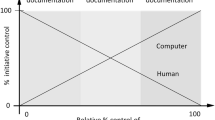Abstract
The universal implementation of electronic health records has transformed the practice of medicine. However, there is a general perception that electronic health records impede effective communication with patients. Clinicians feel that they paradoxically spend more time doing nonclinical tasks like documentation and writing orders and less time interacting with their patients. This article evaluates the role of medical scribes in augmenting physician workflows and examines if employing a scribe can enhance physician-patient interactions.
Similar content being viewed by others
References
Papers of particular interest, published recently, have been highlighted as: •• Of major importance
Blumenthal D. HITECH launching. N Engl J Med. 2010;362(5):382–5.
Poon EG et al. Effect of bar-code technology on the safety of medication administration. N Engl J Med. 2010;362(18):1698–707.
King J et al. Clinical benefits of electronic health record use: national findings. Health Serv Res. 2014;49(1 Pt 2):392–404.
Mandl KD, Kohane IS. Escaping the EHR trap—the future of health IT. N Engl J Med. 2012;366(24):2240–2.
Simborg DW, Detmer DE, Berner ES. The wave has finally broken: now what? J Am Med Inform Assoc. 2013;20(e1):e21–5.
Makam AN et al. The good, the bad and the early adopters: providers’ attitudes about a common, commercial EHR. J Eval Clin Pract. 2014;20(1):36–42.
Weis JM, Levy PC. Copy, paste, and cloned notes in electronic health records: prevalence, benefits, risks, and best practice recommendations. Chest. 2014;145(3):632–8. Detailed overview of documentation issues while using electronic health records.
Witt RC, Haedtler DR. Nurse-scribe system saves time in the E.D. J Emerg Nurs. 1975;1(1):23–7.
Gellert GA, Ramirez R, Webster SL. The rise of the medical scribe industry: implications for the advancement of electronic health records. JAMA. 2015;313(13):1315–6. Overview of medical scribe industry and concerns with scribe use.
Shultz CG, Holmstrom HL. The use of medical scribes in health care settings: a systematic review and future directions. J Am Board Fam Med. 2015;28(3):371–81. Pooled analysis of clinical studies looking at the effectiveness of scribes.
Soudi A, McCague AB. Medical scribes and electronic health records. JAMA. 2015;314(5):518–9.
Koshy S et al. Scribes in an ambulatory urology practice: patient and physician satisfaction. J Urol. 2010;184(1):258–62.
Bastani A et al. An ED scribe program is able to improve throughput time and patient satisfaction. Am J Emerg Med. 2014;32(5):399–402.
Bank AJ et al. Impact of scribes on patient interaction, productivity, and revenue in a cardiology clinic: a prospective study. Clinicoecon Outcome Res. 2013;5:399–406.
Dube K. Re: The use of medical scribes in health care settings: a systematic review and future directions. J Am Board Fam Med. 2015;28(5):684–5.
Author information
Authors and Affiliations
Corresponding author
Ethics declarations
Conflict of Interest
Smitha P. Menon declares that she has no conflict of interest.
Human and Animal Rights and Informed Consent
This article does not contain any studies with human or animal subjects performed by any of the authors.
Additional information
This article is part of the Topical Collection on Palliative Medicine
Rights and permissions
About this article
Cite this article
Menon, S.P. Maximizing Time with the Patient: the Creative Concept of a Physician Scribe. Curr Oncol Rep 17, 59 (2015). https://doi.org/10.1007/s11912-015-0484-7
Published:
DOI: https://doi.org/10.1007/s11912-015-0484-7




